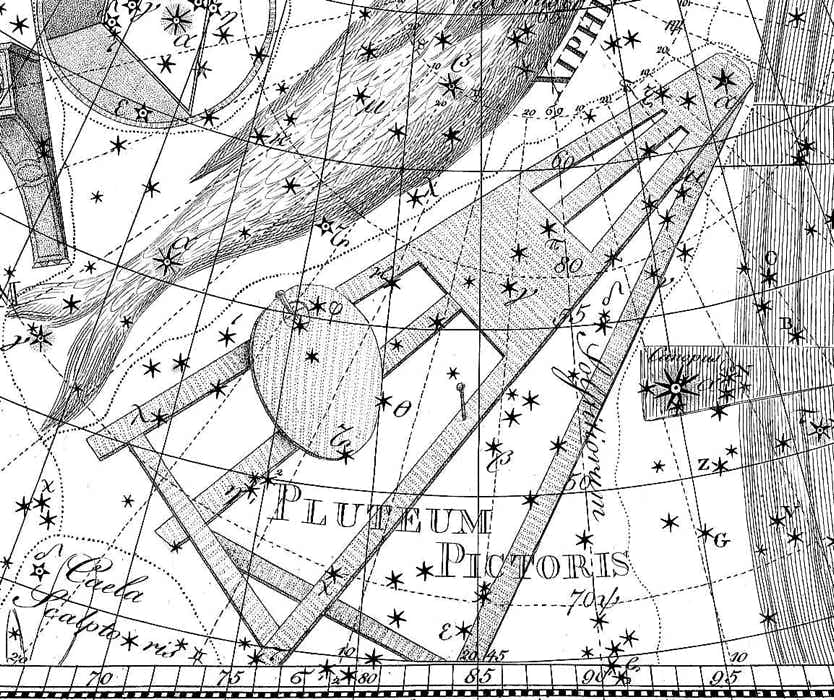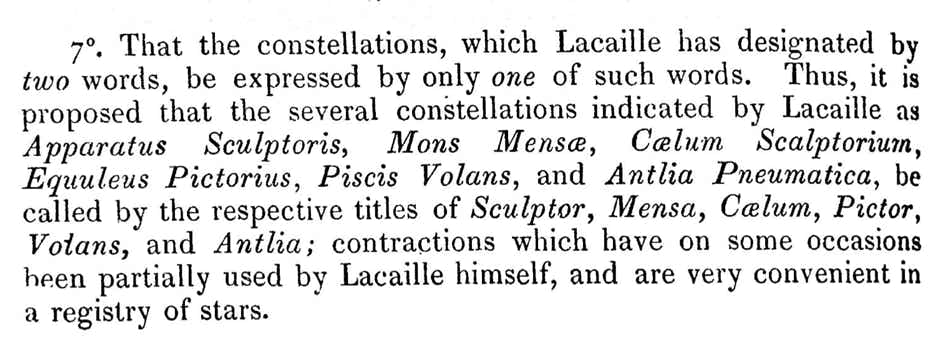
Genitive: Pictoris
Abbreviation: Pic
Size ranking: 59th
Origin: The 14 southern constellations of Nicolas Louis de Lacaille
One of the constellations representing technical and artistic apparatus introduced into the southern sky by the Frenchman Nicolas Louis de Lacaille after his observing expedition to the Cape of Good Hope in 1751–52. It lies under the keel of the now-dismembered Greek constellation Argo Navis, the ship of the Argonauts, next to the bright star Canopus. In fact the four brightest stars in Pictor, labelled α, β, γ, and δ by Lacaille, had been catalogued by the Dutch explorer Frederick de Houtman as part of Argo a century and half earlier.
Lacaille’s original title for the constellation, as given on his planisphere of 1756, was le Chevalet et la Palette, the easel and palette, although in the accompanying star catalogue it was given simply as le Chevalet. In the notes to his catalogue, published in the Histoire de l'Académie royale des sciences in 1756, Lacaille described it as ‘The Painter’s Easel, to which is attached a palette’ (Le Chevalet du Peintre, auquel est attaché une palette). In 1763 Lacaille Latinized the name to Equuleus Pictorius (sic), while Johann Bode in his Uranographia of 1801 termed it Pluteum Pictoris, as illustrated below.
In 1844 the English astronomer John Herschel proposed shortening the name to Pictor. This suggestion was adopted by Francis Baily in his British Association Catalogue of 1845 and it has been known as Pictor ever since.
Pictor, shown with the name Pluteum Pictoris on Chart XX of the Uranographia star atlas of Johann Bode (1801). Bode closely followed Lacaille’s original depiction of this constellation, unlike in many other cases. The bright star at centre right is Canopus on the steering oar of the ship Argo.
© Ian Ridpath. All rights reserved
Lacaille described Pictor as ‘Le Chevalet du Peintre, auquel est attaché une palette’ (The Painter’s Easel, to which is attached a palette) in the notes to his catalogue, published in the Histoire de l'Académie royale des sciences in 1756. He later Latinized this to Equuleus Pictorius, which in turn was eventually shortened to just Pictor.
John Herschel proposed shortening the names of six of Lacaille’s southern constellations from two words to one in a paper published in the Monthly Notices of the Royal Astronomical Society in 1844. His proposal was readily adopted, and we now know these constellations as simply Antlia, Caelum, Mensa, Pictor, Sculptor, and Volans.





